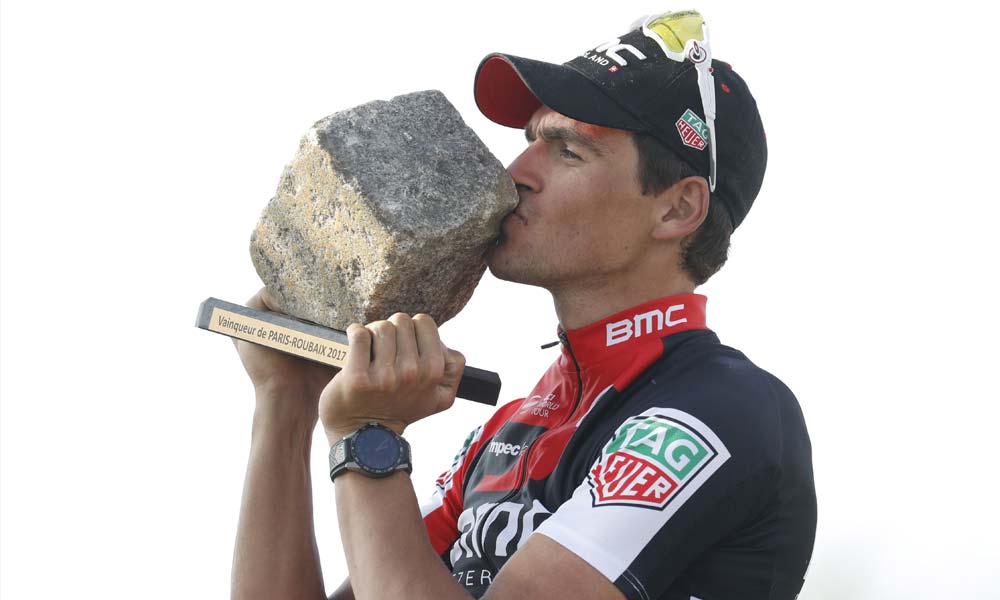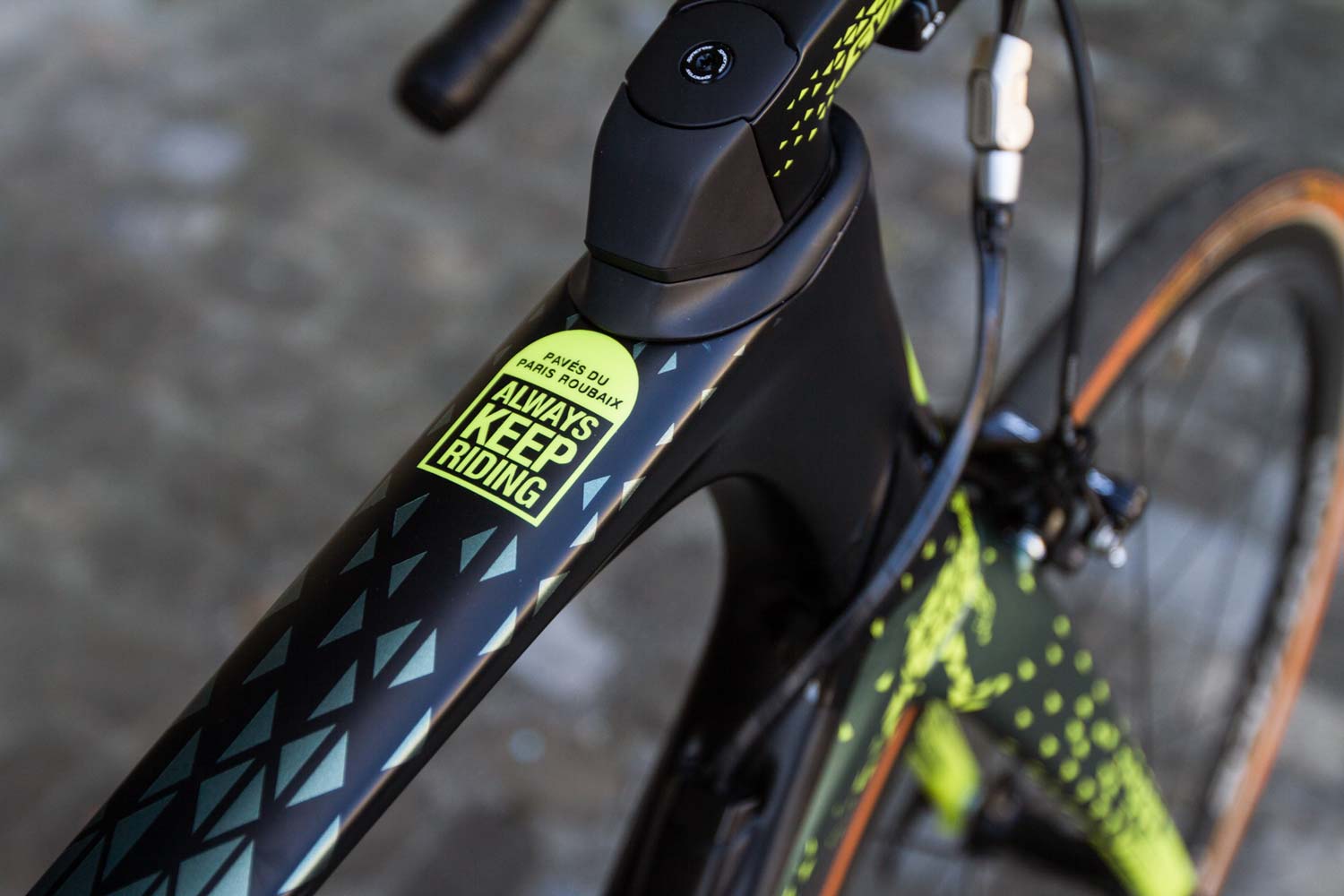[et_pb_section bb_built=”1″ admin_label=”section”][et_pb_row admin_label=”row”][et_pb_column type=”1_4″][et_pb_text admin_label=”Text” background_layout=”light” text_orientation=”left” use_border_color=”off” border_color=”#ffffff” border_style=”solid”]
Paris-Roubaix elicits emotions. It’s more than just another bike race. It is a bizarre contest at a peak time of the cycling season. The stories conjured by 257 kilometres of racing on one special day of the year will be told and retold for years to come.
– Photos: Yuzuru Sunada
[/et_pb_text][/et_pb_column][et_pb_column type=”3_4″][et_pb_text admin_label=”Text” background_layout=”light” text_orientation=”left” use_border_color=”off” border_color=”#ffffff” border_style=”solid”]
There are so many elements of Paris-Roubaix that no amount of TV coverage can possibly capture all that unfolds. But still we tune in and watch hour after hour of what seems to be a sequence of highlights because there is always action. It’s fast, manic, frightening even. It’s nonsensical, random, brutal. It’s like a fantasy but, at the same time, oh so real.
It is sport but there’s a lot more to it than athletic endeavour alone.
Paris-Roubaix is many things to many people. Ultimately it’s a gladiatorial event that is compelling to watch.
Back here in Australia, where we tune in during the late evening and watch on as Sunday turns to Monday, it lures us in and we stare at the screen in awe. We may be watching on TV from the other side of the planet, but the stones still shake us and the impact – although only virtual – provides a viewing experience that seems to have another dimension.
What other race prompts you to bounce around in your lounge quite like Paris-Roubaix?
Other bike races are interesting but there’s something about the Queen of the Classics that makes it a stand-out event, a highlight of the season, a reminder of how amazing cycling can be.
[/et_pb_text][/et_pb_column][/et_pb_row][et_pb_row admin_label=”Row”][et_pb_column type=”4_4″][et_pb_image admin_label=”Image” src=”https://www.ridemedia.com.au/wp-content/uploads/2017/04/GVA-Sunada-Roubaix.jpg” show_in_lightbox=”off” url_new_window=”off” use_overlay=”off” animation=”left” sticky=”off” align=”left” force_fullwidth=”off” always_center_on_mobile=”on” use_border_color=”off” border_color=”#ffffff” border_style=”solid” /][/et_pb_column][/et_pb_row][et_pb_row admin_label=”Row”][et_pb_column type=”1_4″][et_pb_text admin_label=”Text” background_layout=”light” text_orientation=”left” use_border_color=”off” border_color=”#ffffff” border_style=”solid”]
[/et_pb_text][/et_pb_column][et_pb_column type=”3_4″][et_pb_text admin_label=”Text” background_layout=”light” text_orientation=”left” use_border_color=”off” border_color=”#ffffff” border_style=”solid”]
It is violent and, frankly, little about this bizarre contest makes any sense. Why would someone organise an event like this? Why would a rider line up knowing that these roads lay in wait? Why would we want to see something that is essentially created to destroy souls?
It’s cycling’s equivalent of Jimmy Sharman’s Boxers.
You pay to see me fall like shrapnel to the floor
What is the reason for this?
There is a reason for this?
What is the reason they keep coming back for more?
[/et_pb_text][/et_pb_column][/et_pb_row][et_pb_row admin_label=”Row”][et_pb_column type=”4_4″][et_pb_image admin_label=”Image” src=”https://www.ridemedia.com.au/wp-content/uploads/2017/04/SAGAN-Roubaix2017.jpg” show_in_lightbox=”off” url_new_window=”off” use_overlay=”off” animation=”left” sticky=”off” align=”left” force_fullwidth=”off” always_center_on_mobile=”on” use_border_color=”off” border_color=”#ffffff” border_style=”solid” /][/et_pb_column][/et_pb_row][et_pb_row admin_label=”Row”][et_pb_column type=”1_4″][et_pb_text admin_label=”Text” background_layout=”light” text_orientation=”left” use_border_color=”off” border_color=”#ffffff” border_style=”solid” /][/et_pb_column][et_pb_column type=”3_4″][et_pb_text admin_label=”Text” background_layout=”light” text_orientation=”left” use_border_color=”off” border_color=”#ffffff” border_style=”solid”]
It’s not logical but it is historic and compelling and there’s something about it that makes it utterly fascinating.
“You convince yourself that it is beautiful,” said Mathew Hayman back in 2014 when he was one of the many dreaming of that elusive win.
“You wouldn’t start if you couldn’t convince yourself that you were in with a good chance… and then it’s disappointing when it doesn’t happen.
“But I look back and think, ‘How did I get myself to that point that I’d convinced myself that this is my lot…?’ Before I know it, I’ll be remembering the good things and not the bad.”
Last year it was so good it seemed unreal. But it did happen. He did win. And he would return. Of course he would.
What is the reason they keep coming back for more? Stubbornness, and the prospect of glory. One win is good, a second would be better. And there he was again, doing his thing. Dancing over cobblestones and making the absurd seem like a logical thing to do. Hayman is a master of this kind of racing. He is one of a special breed: a racer for the Classics – but he couldn’t conjure a repeat of the fairytale.
You may have watched through blurry eyes early in the morning from the lounge in Australia, fingers crossed in the hope of a miraculous title defence from one of sport’s genuinely good people. Hayman was in with a whiff, of course he was. With the number-one dossard, he had a strong presence but he wasn’t going to provide us with a repeat. Eleventh in 2017.
* * * * *
[/et_pb_text][/et_pb_column][/et_pb_row][et_pb_row admin_label=”Row”][et_pb_column type=”4_4″][et_pb_image admin_label=”Image” src=”https://www.ridemedia.com.au/wp-content/uploads/2017/04/BOONEN-Roubaix.jpg” show_in_lightbox=”off” url_new_window=”off” use_overlay=”off” animation=”left” sticky=”off” align=”left” force_fullwidth=”off” always_center_on_mobile=”on” use_border_color=”off” border_color=”#ffffff” border_style=”solid” /][/et_pb_column][/et_pb_row][et_pb_row admin_label=”Row”][et_pb_column type=”1_4″][/et_pb_column][et_pb_column type=”3_4″][et_pb_text admin_label=”Text” background_layout=”light” text_orientation=”left” use_border_color=”off” border_color=”#ffffff” border_style=”solid”]
There was a delay at the start. The wind insisted on it: to keep the race on – or near to – schedule, the organisers opted to postpone the roll-out for 15 minutes. It might have had something to do with TGV scheduling, for the race to Roubaix has been known to be interrupted at railway crossings; on more than one occasion the boom gate has had an influence. But, really, it was probably more to do with TV times.
Eventually the peloton started to roll. Ahead was 257km, including that special menu of pavé that makes Paris-Roubaix so unique.
It seems to be coming for a long time and then, in a blink, it’s over.
Five hours 41 minutes and seven seconds later it was over.
The wind blew. The sun shone. And the riders raced through the dust and over the stones and onward to the velodrome. And now the stories are being recounted, as they will be until next year’s race.
It is the fastest edition in the 115 years this race has been contested. The winner’s average speed was 45.207km/h!
The 2016 Olympic champion would win a Monument in 2017. Greg Van Avermaet delivered on his promise.
“I always believed that I could do it…”
“When you win, you get more confident…”
“It’s nice to win on the last day of Tom Boonen…” Etc.
He speaks well. He is polite and correct with his post-race commentary but Van Avermaet’s true charisma is on display when he races. He has belief. He has the capability. He has the team support. And now he has another conquest to consider when he’s sitting around talking about his glory days.
Victory for the Belgian. A big rock for the trophy cabinet. Another spot in cycling’s history books. GVA, we salute you.
Tactically savvy throughout, he managed his power and unleashed the kind of sprint that everyone expected. You’ve seen the end. You know the scene.
You can read the various race reports and consider the many quotes issued by teams overnight. You can watch your recording again and consider all the elements you missed on the original viewing. You can imagine what the riders must be feeling like now after such a fast race from Compiègne to Roubaix. You can ask yourself why it is that anyone would consider doing this.
You can conclude that it doesn’t make sense. But sometimes sport is instinctive. There doesn’t need to be logic for it to be captivating.
– By Rob Arnold
(For analysis of the 2017 race by the 2016 champion see our interview with Mathew Hayman.)
[/et_pb_text][/et_pb_column][/et_pb_row][et_pb_row admin_label=”Row”][et_pb_column type=”4_4″][et_pb_image admin_label=”Image” src=”https://www.ridemedia.com.au/wp-content/uploads/2017/04/Podium2017.jpg” show_in_lightbox=”off” url_new_window=”off” use_overlay=”off” animation=”left” sticky=”off” align=”left” force_fullwidth=”off” always_center_on_mobile=”on” use_border_color=”off” border_color=”#ffffff” border_style=”solid” /][/et_pb_column][/et_pb_row][/et_pb_section]




